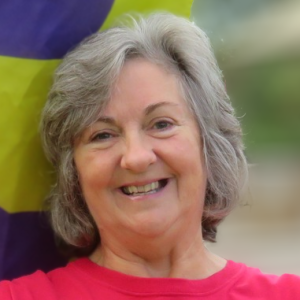
In this two-part series, Nerelie Teese, certified Laughter Yoga leader and qualified Chair Yoga instructor, will outline the benefits and practicalities of Laughter Yoga and Chair Yoga for aged care residents.
The first and possibly most important benefit for participants of all ages from Laughter Yoga and Chair Yoga is that there is absolutely no on-floor work at all.
This means no-one, participants or carers, need to worry about getting down onto the floor or – possibly even more concerning – getting back up again.
And as laughter is known as the best medicine, Laughter Yoga provides the perfect way to immediately feel the physical and mental benefits of a jolly good belly laugh.
Laughter Yoga was developed by Dr Madan Kataria in Mumbai, India, in 1995. Since then it has become an international movement with more than 6,000 clubs in over 60 countries. Laughter Yoga groups operate in all Australian states.
A Laughter Yoga group session enables people to laugh even when they don’t feel like laughing. The combination of laughter exercises and yoga breathing results in improved health, wellbeing and happiness for participants.
Because Laughter Yoga is a body-to-mind activity, our bodies can’t tell the difference between real and simulated laughter. However, the brain picks up on the fun that the body is having and starts releasing powerful neurochemicals including dopamine, oxytocin, serotonin, endorphins and melatonin, which all result in improved physical and mental health and wellbeing.
Laughter Yoga offers a low-intensity physical aerobic activity in a safe and accessible way for everyone. The diaphragmatic breathing in Laughter Yoga sessions has been described as ‘jogging on the inside’ and massages the internal organs while delivering more oxygen throughout the body and to the brain.
Medically proven benefits of Laughter Yoga include boosting the immune system, regulating blood flow, increasing oxygen throughout the body and brain and providing pain relief. Improved stress management and decreased depression and anxiety are other proven benefits that Laughter Yoga participants experience.
A 2017 feasibility study into laughter yoga activities for people in residential aged care homes in Australia resulted in a Policy Impact recommendation that Laughter Yoga should be included in regular activities programs for residents. This is because residents and staff will receive the benefits from having fun and happiness on a regular basis.
The study also found that Laughter Yoga improves happiness and positive mood and has the potential to lower blood pressure. Socially, it provides opportunities for residents to exercise, have fun and enjoy themselves. Another formal recommendation from the study was that Laughter Yoga should be incorporated into lifestyle programs as the negative mood of older people in residential and aged care homes can be reversed.
So, what does a Laughter Yoga group session look like? A passerby or onlooker would see and hear a group of people, usually in a large circle, smiling, laughing, clapping, moving their arms and upper bodies and generally having fun and enjoying themselves.
Because floor work is not part of a Laughter Yoga session, there is no need for yoga mats or sports or exercise clothing. Shoes and footwear are optional.
Participants can remain seated for the entire session. This provides inclusivity for residents with mobility issues as wheel chairs or walking frames can easily become part of the group.
Towards the end of the Laughter Yoga session, a guided relaxation segment slowly and deliberately slows and stops the laughter before participants move into a state of calmness and tranquility.
At the end of the Laughter Yoga session and just before socialising with refreshments, participants are encouraged to talk about their experience and how they’re feeling.
Responses are always positive. Occasionally people are surprised at how refreshed and re-energised they feel and they often describe a pleasant tingling coming from the oxygen rich blood that has been circulating throughout their body.
‘Improved mood’ is the most experienced response after my Laughter Yoga sessions, followed closely by feelings of relaxation and serenity.
Carers have often told me that they see a range of positive facial expressions and relaxed body language throughout the session, which indicates that participants are getting many benefits from the experience.
Importantly, people diagnosed with Alzheimer’s – and their carers – can also benefit from regular Laughter Yoga sessions.
A 2010 Alternative Health Medicine article about Laughter Yoga in a number of Florida senior centres reported that “Alzheimer’s patients live in the moment, so when they’re laughing, you can see that, in that moment, they’re happy”.
Laughter Yoga is not a cure. For groups in more advanced stages of dementia, the response – and the laughter – dwindles. But disabilities professionals still remain enthusiastic about the benefits of Laughter Yoga on their patients.
“When I first heard about it, I thought it was silly,” admitted Angela Aracena, one Miami centre’s director of adult day services. “But when I saw it, it makes sense. Laughter brings more oxygen into the body and stimulates motion, stability and balance. It generates the feel-good endorphins and that boosts the immune system.”
At first, participants may feel self-conscious about being in a Laughter Yoga session. Once they realise that everyone around them is doing the same thing and laughing at the same time, their sense of enjoyment and having fun takes over. And this is when the health and wellbeing benefits of Laughter Yoga become real.
Nerelie Teese is a certified Laughter Yoga leader and qualified Chair Yoga instructor.
References
‘Laughter Yoga activities for older people living in residential aged care homes: A feasibility study.’
http://www.thehappydemic.com.au/wp-content/uploads/2015/11/Ellis_et_al-2017-Australasian_Journal_on_Ageing.pdf
‘Is Laughter Yoga the best medicine for dementia?’
https://www.aarp.org/health/alternative-medicine/info-12-2010/is_laughter_the_best_medicine_for_dementia.html

